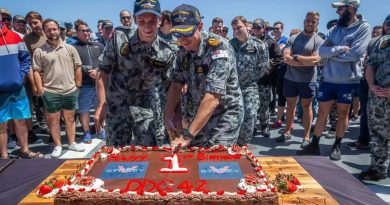Extraordinary tale behind extraordinary documents
Share the post "Extraordinary tale behind extraordinary documents"

The story of coincidence, persistence and happenstance – a set of historic documents uncovered at the Australian High Commission in London highlighted the depth of the relationship between Australia and Britain and the unique friendship between a future senior naval officer and a future King.
CAPTION: Photos of Lieutenant McWilliam, foreground right, and Captain McWilliam, foreground left; his diary, back left, and his midshipman’s journal, back right. Story and photo by Lieutenant Commander John Thompson.
Letters, diaries, a journal and some photos belonging to the then Royal Navy Captain Henry Hastings McWilliam were discovered in a cupboard in the High Commission three months ago. They had been lent to the Australian War Memorial more than a decade ago to archive as part of Australia’s war history.
As a midshipman, Captain McWilliam served on the Indefatigable-class battlecruiser HMAS Australia in World War 1.
The artefacts were due to be returned to the McWilliam family in 2013, but he died before they could be handed back. It wasn’t until June this year when RAN’s Lieutenant Charlie Marshall rediscovered the precious artefacts.
“I’d been asked to do a clean-out of some of our cupboards because we were running short of storage space. As I was going through one cabinet, I came cross some carefully bundled and tied documents. Even on a cursory look, they seemed very important,” Lieutenant Marshall said.
As he flicked through the files, he noticed photos of a youthful future King Edward VIII and some letters written by the then Prince of Wales to his friend Captain McWilliam, as well as diaries and a midshipman’s journal.
CAPTION: Royal Naval College, Osborne, term photograph (1911). Henry McWilliam, back row left, HRH The Prince of Wales, front row left.
“It was clear that these were important and priceless documents that needed to be returned to their rightful owner. If only it was that straightforward,” he said.
Lieutenant Marshall approached the Australian War Memorial, the Sea Power Centre and even went through the Who’s Who reference book looking for members of the McWilliam family, but without success.
“I needed to ‘Sherlock Holmes’ it,” he said.
On a tip from the Head of Australian Defence Staff in London, Brigadier Grant Mason, he started trawling through LinkedIn and finally tracked down Captain McWilliam’s grandson, Simon, in London.
“Out of the blue, I got a message from this stranger called Charlie who wanted to check that my grandfather was Captain Henry McWilliam – I told him that he was. It was then that Charlie mentioned he had some important papers to give me and my family,” Mr McWilliam said.
An official handover was arranged at the Australian High Commission with Mr McWilliam’s mother, Veronika, who happened to be in London from France, and his brother Giles, who coincidentally was visiting from the United States.
“This handover means a huge amount to us – I had forgotten that these documents existed but I knew my father was always good at recording our family history. We’re absolutely delighted to have them back, and grateful to Charlie and the rest of the High Commission team,” Mr McWilliam said.
Among the artefacts was a letter to “My dear McWilliam” from the Prince of Wales to the young midshipman when he was being held by the Germans as a prisoner of war.
CAPTION: Letter from the future King Edward VIII, the then Prince of Wales, Prince Edward, which was censored before being delivered to the then Sub Lieutenant McWilliam while he was a German prisoner of war.
The pair had become firm friends as young teens studying at the Royal Naval College Osbourne, in readiness for life in the Royal Navy.
Captain McWilliam became a prisoner of war not long after transferring to the Tribal-class HMS Maori, which was sunk by a German sea mine in the North Sea.
“The wartime censor had in fact censored parts of the Prince’s letter but left in references to the human cost of the war including the tragic deaths of friends they had in common. The letter is particularly humanising and poignant,” Lieutenant Marshall said.
The artefacts had originally been lent to the Australian War Memorial by Captain McWilliam’s son, David McWilliam, and husband of Veronika.
“I’m upset that my husband wasn’t here for the ceremony today. I’m also cross at him that he never told me about these documents,” Mrs McWilliam said.
“But in all seriousness, I’m incredibly touched that they have been looked after so well and valued so highly by the Royal Australian Navy.”
CAPTION: Captain McWilliam’s family, from left, Giles (grandson), Veronika (daughter-in-law) and Simon (gradson), with Lieutenant Charlie Marshall. Photo: Lieutenant Commander John Thompson
.
.

.
.
Share the post "Extraordinary tale behind extraordinary documents"








